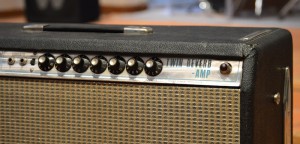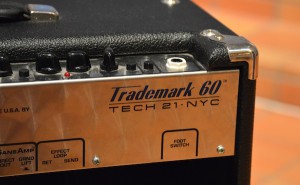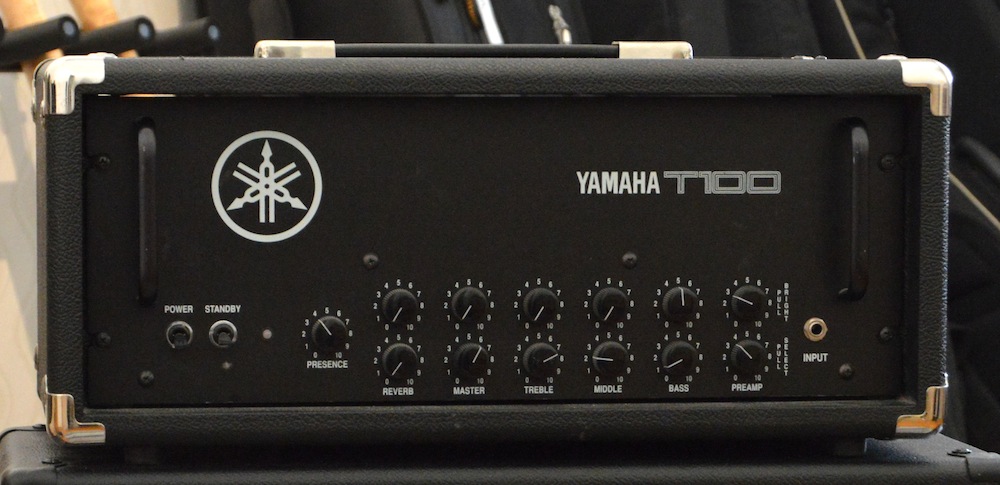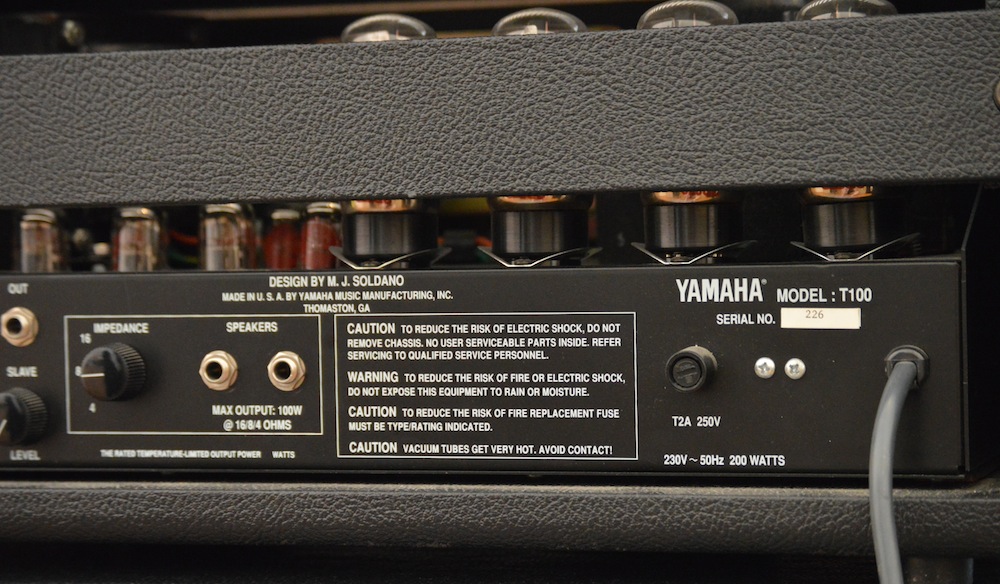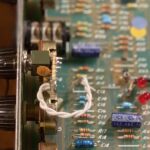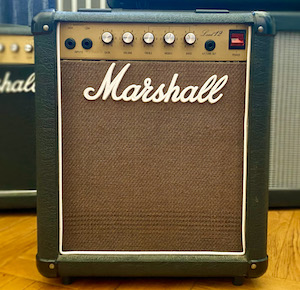1970 Fender Twin Reverb
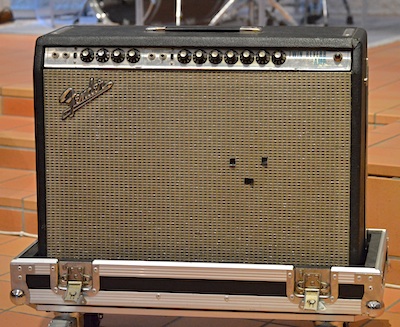
I got this after selling a Mesa/Boogie Blue Angel 2×10″ that I really liked, but couldn’t get to gel with the Tube Screamer type overdrives I used at the time. Like the title says, it’s a 1970 Twin Reverb that was officially imported to Sweden by Hagström. The amp came with grey basket JBL D120F speakers, which I have now replaced for a pair of Jensen C12N’s instead (saving a large chunk of weight in the process).
It is in good working condition, but could use a set of fresh electrolytic capacitors – at times, the amp does emit a ”motorboat” noise, which is usually a sign of old and leaky caps. It could also use some new tolex for the bottom section, which is missing completely. The original footswitch is missing, but after a quick check what it’d cost to get a replacement from Fender, I decided to build one myself. It only has one switch (for the tremolo) as I never turn the reverb off anyway. The first thing I did was to add four good-sized rubber feet as the old ones were long gone. Fender didn’t put castors on these amps until 1972, so I didn’t want to add them now. Later, I got a flightcase for this amp, which has made transporting it far easier. Granted, the case itself weighs quite a bit, so lifting the thing into the back of my car is quite an event… 🙂
The amp was originally believed to be a ’69, but further inspections has confirmed it to be an early ’70. Not that there’s much difference – the ’68 – ’69 silverface amps had an aluminium trim around the edges of the baffle/grille (which was in one piece until ’72), but this amp doesn’t have it. Apart from that, it’s the same as the first generation SF Twins. I love this amp – it sounds absolutely fantastic at medium volumes and up, and I can’t ever see myself selling it. As mentioned, I have replaced the JBL speakers for a pair of Jensen C12N speakers, which sounds great (once they’d been broken in). A bit fatter, with more speaker breakup and a less ”clean” sound. And of course, the lighter weight was also welcome. So now I have a pair of original late 60’s grey basket D120F’s laying around…
1969 Fender Bandmaster Reverb 2×10″ combo
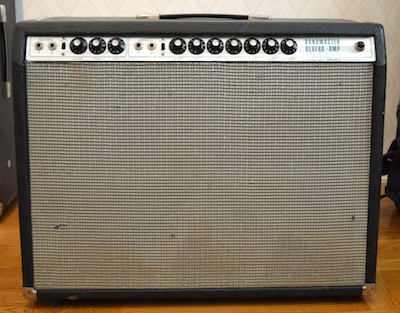
While on yet another lookout for a smaller companion to the Twin, I came across an ad for a Bandmaster Reverb head, with an accompanying 2×12″ closed-back cab (listed below) and a 2×10″ Fender combo cabinet. The amp was quickly dated to june-august 1969, and the head cabinet has the aluminium trim typical for 1968-69, but with black grille cloth. I don’t know if it came like that, or if the cloth has been replaced at some point. Other than that, the head cabinet is in excellent condition, with no nicks and tears in the tolex.
The 2×10″ combo cab (which houses the actual amp) is actually a cut down Super Reverb – it has a SR tube chart inside, and it is clearly visible that the cab has been (crudely) modified. The setup needed a little TLC – new speaker wire, new cables to/from the reverb tank, proper rubber feet etc – but as a whole it works just fine. It currently has the two Jensen C10R speakers it came with. Sonically, the amp sounds wonderful – very full and smooth, with a nice slight breakup the Twin doesn’t have (unless it is cranked to stupid levels). The reverb is as awesome as always, and the tremolo does what it’s supposed to. And with the Jensens, it is surprisingly light!
The amp itself is a TFL5005X model, which is the first time I’ve heard of the ”X” designation – they usually have a ”D”. If I were to guess, I’d say the ”X” is for ”Export”, with the ”D” for ”Domestic”. Hey, it’s a guess, at least…
But… as with any 40 year old amp, there are niggles. And this one seems to have more than its fair share. The first time I took it to a rehearsal (thankfully, it wasn’t a gig, at least), it sounded awesome the first 40 minutes, and then started fading off until it was distorting and spitting like a bad fuzz pedal. After a few trips to the doctor, the picture is starting to get clearer. So far, we’ve found:
- a couple of bad resistors
- a bad solder joint on the heater wire for one of the tube sockets (causing the amp to fry one of the power tubes, once it got hot enough)
- the power transformer was set up for 220 volts AC input, while the actual line voltage here these days are over 230 volts (I’ve measured 236 volts at my house). This meant the tubes were getting too much voltage. Thankfully, the transformer had a 240 volt input as well, so the tech quickly rewired it to match the modern line voltage.
But still the amp fizzes out after an hour or so, along with a nasty smell. The new theory is that its output transformer isn’t right – while Bandmasters in general seem to be fine with a 4 ohm load, this one might not be. At the amp tech’s workshop, it was hooked up to an 8 ohm dummy load for testing, and worked perfectly for hours. It might be the output transformer that is weak, wired the wrong way (using only the 8 ohm output, for instance) or simply the wrong type. Sigh… more to come, I suppose. Too bad, because it sounds absolutely ripping when it works.
1973 Fender Bassman head
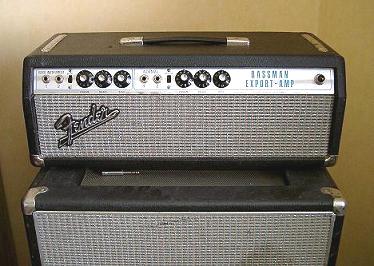
This one I found in an advert while I was away for a couple of weeks. A phone call later, I had secured the amp. We decided to talk more when I had returned home, and arrange the transport (as the amp was located in Sundsvall, 400-odd kilometers from Stockholm). I got home Sunday night, and Monday morning the owner called, telling me that he was leaving for Stockholm right away. He wanted to know if he should bring the amp… Needless to say, I said yes, and we met up later that day. I walked into a room full of amps, and in the center was a Steinway Grand, stripped of its strings and keys – apparently, the guy repairs grand pianos for a living… A cool job, indeed! And a cool guy, to boot – thanks Lars, for selling me this jem!
The amp is a 50 watt export model, which was manufactured in parallel to the regular US model. It’s the same as a Bassman (renamed ”Bassman 50” in 1972), only with a 220 volt power transformer. Of course there were other export models as well, which had voltage selectors (either on the back plate or internal), but the ones with a fixed 220 volt tranny seems to be the only ones that actually said ”export” on the faceplate. Weirdly, in contrast to the Bandmaster Reverb, this one doesn’t seem to mind at all that the mains voltage these days is quite a bit higher than 220 volts… Anyway, dating this one was a breeze, thanks to my good friend Dirk (singlecoil.com). From the serial # A57934, we can deduct (or rather, he could) that it was built in april 1973.
The amp sounds great – it growls and barks, but in a softer, more mellow way than the ’72 50w Marshall I used to have. I bought it to power my Fender Vibratone leslie, a job it does admirably, but it has also been used as a stand-alone amp with a 2×12″ cab, and lately it’s also been used as a bass amp (with an EBS Classic 1×12″ cab). I’ve also bought a case for it, so now it rides in comfort and style 🙂
Tech 21 Trademark 60
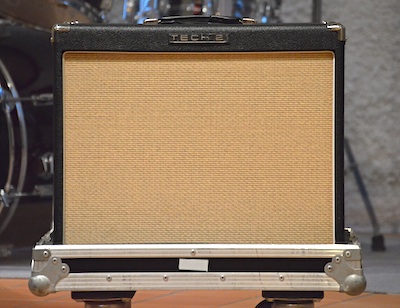
Way back, when the Trademark 60 was first released in Sweden (or at least when the music store I frequented at the time were thinking about carrying it), I received one as a loaner/test amp, to give my impressions of it. I took it to a gig, and remember being mightily impressed by the way this little (not to mention lightweight!) amp handled itself. I played the whole gig with just the amp and its footswitch (for channel and boost switching). I might have had a tube screamer in there as well, just to kick the dirt up a notch, but that was it. There were just so many different sounds you could get from that little amp, that it completely blew me away. And having an onboard clean boost for solos just makes it so much more versatile… For some reason, I never got around to buying one, though I’ve had it in the back of my head ever since – it could be the perfect rehearsal/small gig and general backup amp. If all else fails, you could easily get through just about any gig with just the amp, its footswitch and some knob tweaking. It even has a dedicated volume boost for solos 🙂
Fast forward to 2013, when I came across this well-kept first edition (with original Tech 21 speaker, rather than the Celestion used in the later models) complete with flight case, for basically practice amp money. I took it home, and once again it blew my mind. As long as you keep in mind that the controls aren’t the same as on a ”normal” amp, and don’t work the same way, there are a million sounds to be had from it.
The two channels aren’t exactly ”clean” and ”distortion” – both can do clean and distorted sounds, but with ”Fender” and ”Marshall” flavours. The midrange controls (”punch” and ”growl”, respectively) control the character of the channel, and as such affect much more than just the midrange. Turning the ”punch” control takes channel 1 from Blackface to all-out tweed Fender, so you can go anywhere from a squeaky clean Fender Twin sound to a spitting Neil Young-esque Tweed Deluxe on 12. The master section then has active (cut/boost) bass and treble controls, which you can use to tailor the sound. You can then mike it as normal, or use the speaker simulated balanced XLR output to feed the PA. I’ve tried it both ways, and with a good-sized PA you’d be hard pressed to tell which is which…
Yamaha T-100
This amp is from the very early ’90s with a quite low serial number (#226). In the late ’80s, Yamaha asked amp designer Mike Soldano to design a dual channel amp for them, and this was the result. Its design shares many bits with the very expensive and coveted Soldano SLO-100, but obviously differs in that the Yamaha has separate tone controls for the two channels. To save a bit on the cost, some corners have been cut compared to the original design, but on the whole, it is a really nice amp. I’ve recently learned that these amps were apparently built for Yamaha by Dennis Kager of Sundown amps fame. Anyway, the amps never really took off – it probably wasn’t cool enough, being a Yamaha and all.
I actually played this very amp when it first arrived in Sweden, and remember really liking it. Even so, I passed (probably for the reason mentioned above), and kept on lusting after a proper Soldano amp. Apparently, so did everybody else who tried it, and the amp ended up unsold and unloved at the back of the music store’s storage room. Fast forward a decade and a bit… Some time in the mid-late ’90s, a friend of mine was looking for an amp to power his Hammond organ through a Vibratone leslie (yup, the one found right on this page). I pointed him towards Estrad Musik (later 4sound Folkungagatan, now defunct) in Stockholm, and told him to ask my friends there if they had something laying around. The T-100 was brought up from the depths of the store, and ended up serving him well for many years.
Fast forward another decade and a bit, and the T-100 was sitting idle once again. The clean channel had failed a good while back, and playing Hammond through just the dirty channel wasn’t really ideal. It was ripe and ready for a change of ownership, thus. And some 20+ years after I first tried it at the store (and really should have bought it), it’s finally home 🙂 I have since repaired the amp – one of the plate resistors to V5 had failed (both of those resistors have now been overkill-upgraded to 2W Metal Oxide resistors, making them unlikely to fail again). Next up is the choke mod, new filter caps throughout, some tweaks to the reverb circuit (the amp is driving the reverb tank way too hard, to the point of feedback on the drive channel) and I will probably also remove the bright cap on the drive channel gain pot. Also, some new tubes would be in order – the amp still has all of the original Yamaha-stamped tubes in it 🙂 That said, only a couple of the preamp tubes are starting to become microphonic – the four 6L6GC power tubes all seem just fine.
Marshall 4203 Artist 30
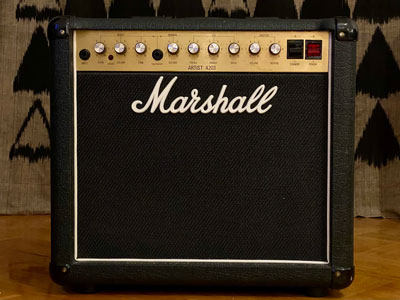
The latest (as of late 2020) addition to the stable. I remember trying the Artist 30 3203 head (3/4 size, like the Lead 100 below) in the late ’80s, and remember describing it as ”John Sykes in a box” – it had that fat 80’s lead tone in spades. But for some reason – probably the ever-present lack of funds that defined my younger years – I didn’t end up buying one. Even so, it sat there stuck in the back of my mind ever since. Fast forward to december 2020, when I came across the combo version for sale. There was only one way that story could end, and I of course snapped it up.
The amp is a 1989 model, and aside from missing one of the plastic feet, and a 4 ohm Celestion G12H-100 in place of the 8 ohm Vintage 30 the amp originally came with, the amp was in really good shape for being 30+ years old. The tubes are of course shot, and a fairly loud 100Hz hum indicates it desperately needs new filter capacitors. But everything on the outside is in perfect nick. And on the inside it is 100% untouched, which I actually prefer – that means I know that everything is the way it left the factory, and anything I change I have control over.
A thorough cleaning of the tube sockets, jacks and pots cured the worst of the crackling and howling noises, but it has also received new tubes and filter capacitors. The ”bright cap” on the normal channel’s volume control has been clipped out, to make that channel a little more mellow. Naturally, I had to tinker with it, so the normal channel now has a three-position bright switch, so I can insert two different sizes of bright cap (should I feel like) or leave it out of the circuit. The speaker is now a 1993 G12T-75 (one of a pair I bought for this purpose). After putting the amp back together, I verified that it worked as intended and that the new bright switch did the trick. The clean channel is now much more useful. I tried switching back and forth between the G12T-75 and a 1989 G12M-70 I have in another cab, to see what difference that made. But honestly, the size difference between the two cabs probably made the test a little unfair. Anyway, the next thing that happened was… nothing. The amp went quiet. I have determined that it is the preamp section that is dead (through the effects return, it works just fine). So after about 10 minutes of being put back together, it now needs to come apart again. Oh well…
Marshall 5005 Lead 12
When this humble Marshall combo popped up on Facebook Marketplace, I was immediately interested. There’s something about those ’80s JCM800 amps that appeals to me – it could well have something to do with re-living ones’ youth 🙂 Anyway, as I happened to be passing by the seller’s location the next day, it seemed like it was meant to be.
The amp was made in 1985 and looks completely stock, with a Celestion G10D-25 speaker that checks out as a 1985 as well. It works perfectly, and dialing in that 800-style Marshall growl was as easy as plugging in and turning up. With the gain set about halfway, the sound is clean and sparkly – even when using the high sensitivity input. At about 7, the tone starts to develop some hair, while still cleaning up nicely with just a lighter touch. The clean-ish tones are fat and warm – much more so that one might expect from a 12 watt solid state combo with a 10″ speaker. The top end can be a bit too rich, though, so the treble pot needs to be set fairly low. And above 8, you really start getting into classic rock territory. You’d probably need a booster or light overdrive to get those ’80s searing lead tones, but for playing Thin Lizzy riffs, there’s more than enough gain available from the amp itself.
Big thanks to Mikke for selling this amp to me!
Marshall 3210 Lead 100 Mosfet

In 1984, Marshall launched a 3/4 scale line of amps, consisting of the 2204S (a 50w single-channel all tube amp), the Artist 3203 (a 30w dual channel solid state preamp/tube power amp hybrid) and this one – the 3210 Lead 100 Mosfet (fully solid state). The line came with straight and slanted 4×10″ (1965A/B) and 2×12″ (1966A/B) cabs, to make up a slightly smaller Marshall stack. I’ve never seen myself using a Marshall very much (I am a Fender guy, after all), but I remember these from when I started getting serious about playing guitar, and thought it could be nice to have one. I’d love to get my hands on the Artist 3203 and one of the matching cabs too.
But what’s it like, you ask? Basically, it’s a loud rock machine. The Normal channel for me stays mostly clean – you can crank it up and tame the volume with the master, but then the Boost channel might have problems keeping up, especially with the ”pull EQ” function engaged. The Boost channel with the gain knob pushed in (not pulled) delivers a very mid-forward solid lead tone, with just a single tone knob for tweaking. Pulling the gain knob out engages the EQ on the Boost channel, which scoops out the midrange while adding bass and treble. The tone becomes quieter, smoother and much more forgiving, but possibly also a little too fizzy and too easily buried in the mix.
There’s no way to manually select channel on the amp itself, so you will need a footswitch to do that. One interesting twist is that the amp doesn’t default to one of the channels if you don’t have a footswitch connected – rather, it runs both channels in parallel. So you can run the amp clean and distorted at the same time.
As with almost all the JCM800-era amps with series effects loops, those jacks need regular cleaning, as oxidation tends to create intermittent connection from send to return jack (when they are not in use). A temporary workaround is to actually use the loop – either as intended, or with just a short patch cable. Also, the pots tend to seize up, requiring a fair amount of work getting penetrating oil down the pot shafts. That done, it is essential to clean the pots’ insides as normal, with proper non-residue electronics cleaner.
Hammer 1×12″ cab
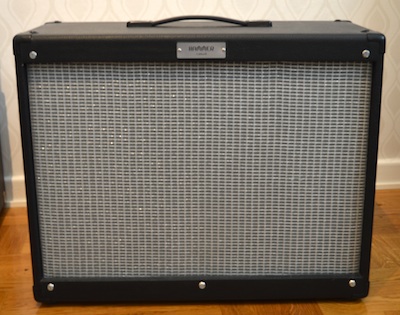
I needed a cab for the Marshall head, and found this one locally (where I lived at the time, I should add). It was built by a guy who – when he feels like it – whip together a few cabs and sell them, and I got it relatively cheaply. It came empty and I loaded it with a 16 ohm Celestion V12-60 I had lying around. At the moment, the cab is loaded with an 8 ohm 1989 Celestion G12M-70, and it sounds just fine.
Crate VC508
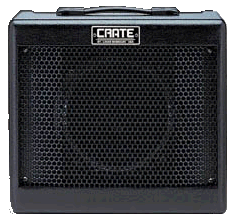
Um… so what is a modern Crate amp doing amongst all the old Fenders, then? Well… the story was – as always – that I was looking for something else, and just happened upon this one. I was going to buy a Roland Micro Cube, actually, to use as a test amp in my workshop. As you may or may not know, I modify pedals in my spare time, and I’d gotten really tired of warming up my Twin every time I wanted to check that a pedal was working properly before I shipped it off to its owner. Basically, I was looking for a tiny practice amp. I had thought about getting a Pignose, but ended up shopping for the Micro Cube. And of course they were fresh out of them in the shop… I told Leffe (at 4Sound Stockholm, previously known as Estrad Musik) what I was looking for, and he whipped out this little puppy. It had been sitting in the shop for quite some time, so I got a great deal on it. Once again, Leffe and the crew at 4Sound Stockholm has hooked me up – I can’t say enough good things about that store and its staff!
Basically, it is a 5 watt class A tube amp with an 8″ Celestion in an open back cab. The controls are deceptively simple – gain, tone and volume – but the amp is still capable of producing a lot of different tones. The amp has a couple of twists and surprises. First off, the tone control is quite odd, and can’t be treated as you would a tone knob on an overdrive pedal. It does not just control the amount of treble – as you turn it from 0 to 5, the tone goes from wooly to very midrangey, and from 5 upwards it starts to decrease the mids and add treble/bass, and at 10 you end up with a fairly scooped sound (as scooped as you can get with an 8″ speaker). Very odd… Second, the preamp is actually a hybrid. The signal first enters a solid state gain stage that in turn drives the first half of the preamp tube. The signal then goes through the tone and master volume section, before it hits the single-ended 5w power stage. I’m guessing this design was something of a shortcut – in order to make the preamp distort to the designer’s liking, they needed that extra gain stage at the start of the circuit. But the amp layout (or more likely the budget constraints) didn’t allow for a second preamp tube to be used, so they stuck a solid state stage in there instead. That isn’t inherently bad, but in this particular amp it sometimes becomes a disadvantage. You have to make sure the input level doesn’t get too strong (i.e. no boosters in front of the amp), and watch the gain control setting. That knob controls the gain in the solid stage gain stage, and if you set it too high, you will distort the op-amp inside. That produces a fizzy distortion that is quite far removed from the power tube overdrive the amplifier type is meant to give. Luckily, the line out jack doubles as a loop, with a third hidden option there as well:
- With a regular guitar cable inserted all the way into the jack, you have a line out (signal taken before the power amp stage).
- A TRS insert cable (stereo plug to two mono plugs) will get you a regular fx loop (tip is send, ring return).
- To access the power amp directly, without sending the signal through the preamp section, plug your guitar cable halfway into this jack (pushing the plug only down to the first ”click”, instead of all the way down). The only control that works is the volume knob, the sound is much cleaner and louder, and there is not a trace of that fizzy solid state preamp distortion you can get when using the amp the ”normal” way. You do need some sort of buffer amp to drive the return, though – plugging the guitar right into there won’t work. But stick a buffered (Boss/Ibanez type) pedal in between the guitar and the amp, and it works just fine.
The amp was mostly meant to live under my workbench, doing duty as a test amp for newly modified pedals. But it got its gig teeth cut after only a couple of days in my possession, and it performed really well, so I suppose it will get to come out and play from time to time. To help transporting it safely, I’ve purchased a soft carrying case for it, complete with shoulder strap and all. A Rockbag softcase for a double bass drum pedal turned out to fit the amp perfectly, with just enough room. If you want to look into it, the Rockbag part # is RB22690B. If you also want room for a couple of pedals in with the amp, there is also a bigger size case – it has the same basic measurements, only a little wider.
I’ve read lots of info about modifications to this amp, but at the moment I’m letting it stay the way it is. Drilling some ventilation holes in the back plate would be a good idea, though – while the amp runs relatively cool under normal bedroom use, as soon as I crank the preamp, it’s starting to give off that ”hot” smell… Also, the amp desperately needs an external speaker jack, so I might put one in. A 10″ speaker could probably be shoehorned in, but that’ll be for later. I’d also like to see what can be done to stop the solid stage gain stage distorting. But who am I kidding – I don’t have that much time… 🙂
1968-72 Fender Vibratone
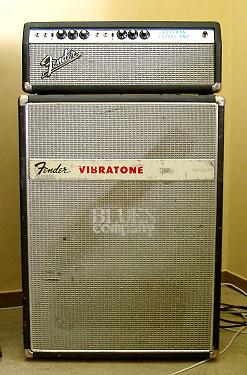
A Leslie 16 in Fender clothing. A friend of mine was using this with his Hammond organ, and desperately needed a ”real” leslie – or so I kept telling him anyway… 🙂 Eventually I found a Leslie 760 with a defective amp section – perfect for turning into a ’speaker-only’ leslie to go with a guitar/bass head – and I kept mailing him pics of 760:s until he reached GAS overload. We took my car and drove 400 km:s to where the seller lived, loaded the beast into the back and headed for home. After a bit of fiddling, which included building a passive crossover, it was ready to go. If you’ve never heard (or rather felt) a cranked Hammond through a big leslie… try it out. It’s better than any drugs. In the meantime, as I had cunningly brought a guitar along, I took the Vibratone for a spin… sorry. I’m sad. I know… Anyway, It turned out to be a good deal for both of us – he got a real leslie (and chronic back pain from hauling the thing) and I got a Vibratone…
It has the aluminium trim that – on the amps – only appeared in ’68 and ’69, but I’ve been hearing that the Vibratone kept the trim all the way to its demise in 1972. The vent slits (top and sides) does not have the aluminium trim, though, which every one of the 1967-1969 ones I’ve seen has had. But I don’t know if they were there from the start but fell off, or if it came without them. So, date-wise, what I can say for sure is that it isn’t a ’67 (the first year, the Vibratone didn’t have the aluminium nameplate), and that it might not be a ’68 or ’69, but I really don’t know any more than that.
Anyway, the crossover network that routed the mids through the leslie and the top+bottom back to the combo amp is long gone – as is the original Utah speaker. Nowadays it’s wired as a regular 8 ohm cab, using a 10″ Celestion. I also built a small footswitch for the ramp up/down, as the original footswitch was lost with the crossover network. I often use the Bassman to power it, with a StinkFoot AB box to switch between the Bassman/Vibratone and whatever other amp I’m using. The Vibratone now lives in a proper flightcase, which I had built for me in a trade for an old Traynor amp. It does make the whole thing a bit bigger in transport, but far easier to move around.
Hagström BT-25-1

My very first amp. I bought it when I was 10 or 11 years old, answering an ad in the local classifieds for an ”electric guitar and amplifier”. The guitar turned out to be a bass, that I promptly traded for a distortion pedal. In hindsight, the guy at the music store probably ripped me off – what did I know about the value of various instruments? – but hey… I was just a kid. Anyway, the amp stuck with me, and I’ve had it ever since. The serial number of this amp is 796193 – I know that makes it the 193rd amp in batch 796, which should place it somehere in the early ’70s, but I don’t know more than that.
The internal 12″ speaker is long gone – it didn’t last very long at all, IIRC – so I quickly installed a jack for an external cab. And it needs a serious cleanup inside – the pots are way past scratchy… I have thought about lobbing a Celestion or Jensen 12″ in the amp, just to see what happens. In any case, I will never sell it. Not that I’d get very much for it anyway, but it’s the principle that counts…
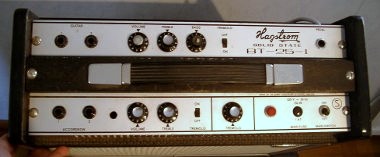
To the right you’ll find a pic of the control panel. I have no idea what the extra hole in the accordeon channel is for – it was there when I bought the amp, and it doesn’t seem to be from the factory. Other than that, it’s very simple. The guitar channel (top) has volume, treble and bass controls, and a slide switch to activate the tremolo. The accordeon channel (bottom) only has volume and treble controls, and another tremolo on/off slide control. The last knob sets the speed for the tremolo effect. The amp – on the guitar channel – is quite dark sounding with lots of bass. I usually end up with the treble at about 6.5 (it really opens up between 6 and 7) and the bass just above 2. With those settings, it’s quite glassy-sounding and plenty loud with the volume at 3. The accordeon channel is very different – rather nasal and midrangey, which I’d guess would be just right for pushing an accordeon through the mix. A really cool amp, but impossible to repair if the power amp should fail – these amps use a complete module that Hagström imported from somewhere, and those bits hasn’t been available anywhere for at least 15 years…
